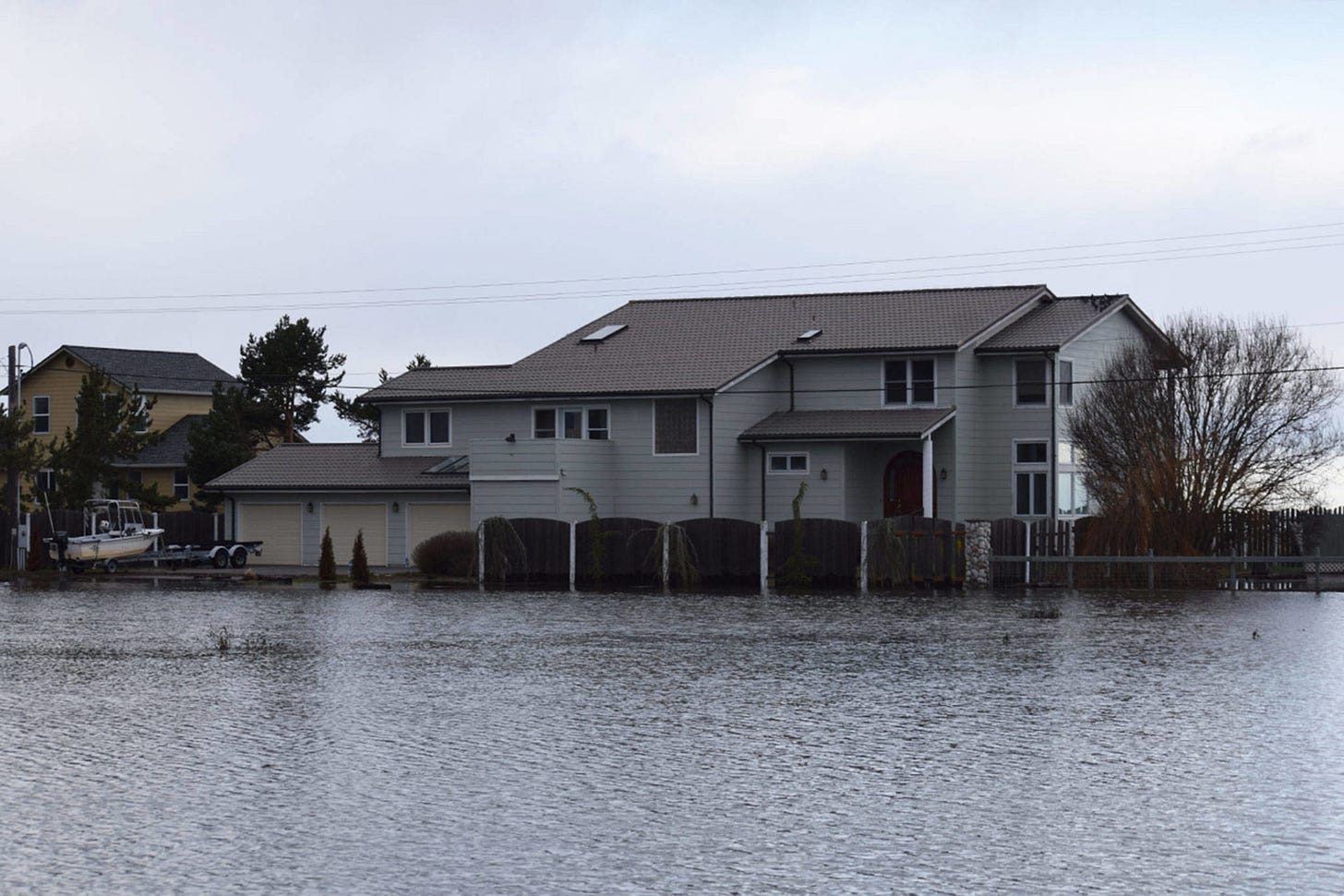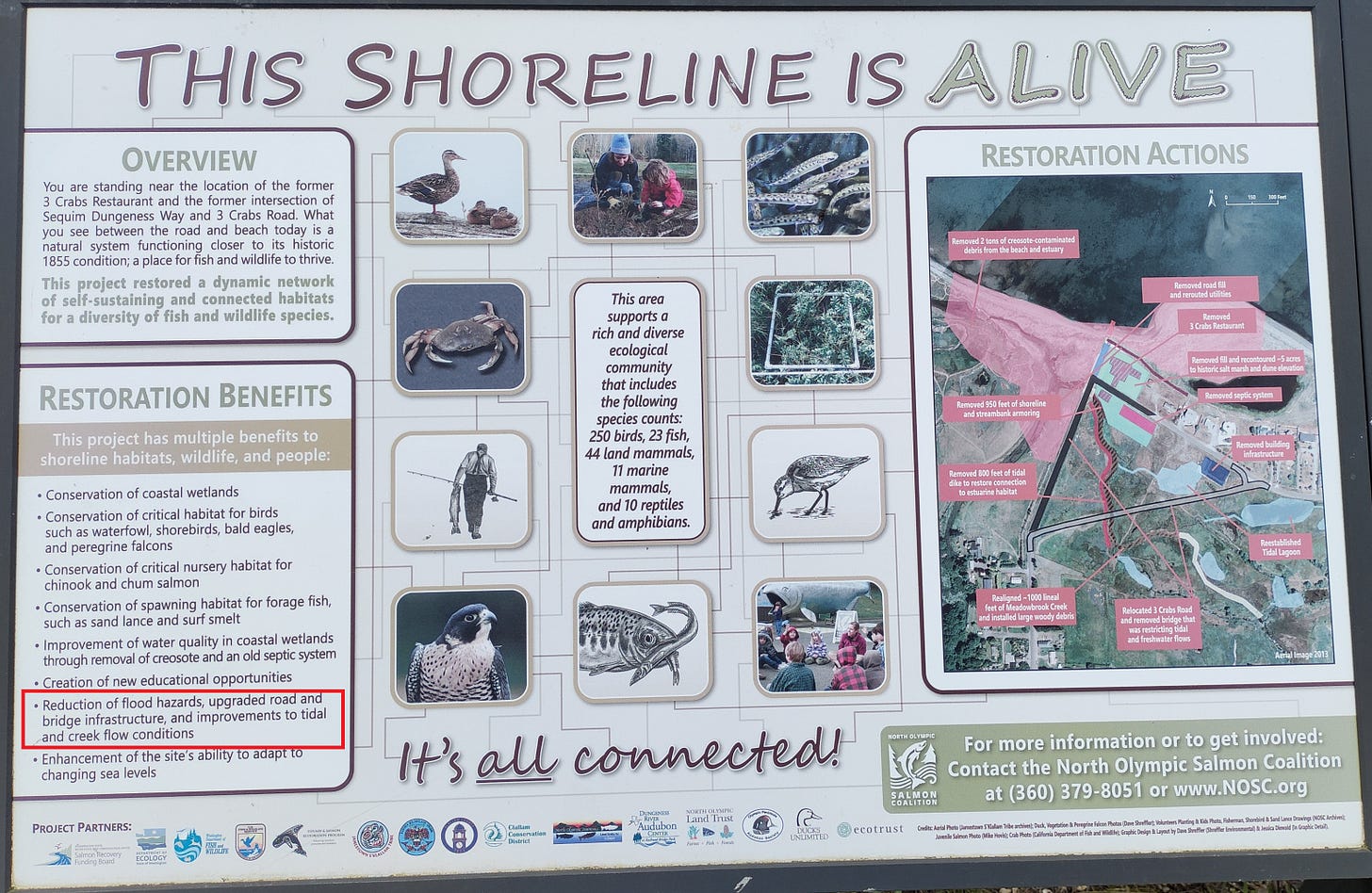A project meant to restore the Meadowbrook Creek estuary was supposed to protect against flooding—but for residents of 3 Crabs Road, the opposite has happened. Homes that never saw water damage are now flooding year after year, with costs piling up and no clear solution in sight. As county officials scramble for funding to study the issue, frustrated homeowners are left asking: Was this disaster preventable? And who will take responsibility?
The residents of the 3 Crabs neighborhood north of Sequim have received a mix of good and bad news regarding their persistent flooding issues. The good news is that, after years of being ignored by their commissioners, the Board has finally applied for grant funding to study the problem. The bad news? Residents will likely endure at least two more years of flooding before a solution is found.
Increased flooding since restoration
According to a newsletter from the Jamestown Tribe, the Ribbon Cutting Ceremony for the completed 3 Crabs Restoration Project took place on December 18, 2018.
Two days later, on December 20, 2018, homes adjacent to the project flooded during an 8-foot tide. According to an article in the Sequim Gazette, resident Dwayne Pettett remarked, “This is the worst I’ve seen it.”
“Ever since the completion of the Meadowbrook restoration project, 3 Crabs has experienced flooding at a severity that was not there before,” Dungeness resident Amanda Stanley told the commissioners last month during a public comment session.
Three Crabs resident Jim Welch added, “The estuary restoration project may have removed some of the infrastructure that protected the area from flooding so severely, although one of the North Olympic Salmon Coalition’s stated benefits was the reduction in flood hazards.”
A plaque displayed at the Meadowbrook Creek Estuary even lists “Reduction of flood hazards, upgraded road and bridge infrastructure, and improvements to tidal and creek flow conditions” as key benefits of the restoration.
Homeowners facing costly damage
Dungeness resident Carlos Arguelles shared his own struggles with the increased flooding. After years of planning, his family finally purchased a home on 3 Crabs Road in 2021. He had researched the property carefully, finding no history of flooding, and even noted that the home still had its original 1973 insulation.
However, shortly after moving in, flooding struck, causing $15,000 in damage. The following year, another flood brought another $15,000 in repairs. This year, a third round of flooding has pushed the total damages to around $50,000.
“We’ve been bringing this up to our elected officials for the last four years with almost no action,” Arguelles said. “Inaction has real consequences for real people. Our family is one of them, as is every other person on 3 Crabs Road.”
The science behind the flooding
Brian Hilderman, a resident of Three Crabs, is dissatisfied with the county’s response. He believes that attributing the flooding solely to climate change and proposing a “relocation strategy” for residents demonstrates that the government is not backing its citizens and only expects them to pay for projects.
Hilderman has turned to science for an explanation of the flooding and has focused his research on barometric pressure, which measures air pressure over land and sea. “A ‘standard’ barometric pressure at sea level (Dungeness) is defined as 1013 millibars,” Hilderman states, according to NOAA. “The higher the pressure, the lower the tides. The lower the pressure, the less weight on the sea, and the tides rise.”
His research revealed that on December 14, 2024, Dungeness faced flooding despite a predicted high tide of only 8.4 feet. However, barometric pressure had dropped to 995.8 millibars, causing the water level to rise an additional 6.8 inches. This, along with winds over 45 knots, resulted in flooding in the neighborhood. Two days later, on December 16th, the predicted tide was actually higher (9.0 feet), but no flooding occurred because the barometric pressure was at a stable 1018 mb.
Structural changes and road damage
Beyond atmospheric pressure, Hilderman believes another major contributor to the flooding is the structural damage caused during the restoration process. He notes that when hundreds of tons of material were removed from the former 3 Crabs restaurant site, it caused measurable stress on the road south of his property, leading to sinking in some areas. These low points now allow water to cross into properties that previously remained dry.

A project excerpt states, “The crest elevation of 3 Crabs Road adjacent to the Project Area will be raised to at a minimum elevation of 9’ NAVD88 in order to reduce flooding of the roadway and improve ingress/egress during flood events.” However, Hilderman’s measurements indicate that his section of the road was never raised. His altimeter shows that the road is still a foot below the promised design elevation.
Removal of the dike
Perhaps most concerning is that a project website openly acknowledges that the original 3 Crabs Road served as an armored dike that separated the estuary from the neighborhood.

By removing the road and reengineering Meadowbrook Creek with new tidal basins, the restoration project brought floodwaters closer to homes, effectively eliminating a protective barrier. Before-and-after photos of the project illustrate that two tidal basins were excavated, allowing water to move closer to the road and homes.
Further complicating matters, another restoration effort—the Dungeness Floodplain project—has inadvertently funneled more water into Meadowbrook Creek. Project partners excavated a deep drainage ditch north of the Dungeness Valley Creamery, which channels water eastward into Meadowbrook Creek. Despite this additional water source, the County has yet to measure its impact on flooding.

Funding a solution
After years of inaction, the County has now applied for a $360,529 FEMA grant to study the flooding problem. If approved, the County will contribute a 12.5% match of $51,054, bringing the total study funding to $412,033.
However, the study itself will take two years to complete. Meanwhile, the residents of 3 Crabs Road face at least two more flood seasons without a solution. This delay is unacceptable for those already dealing with thousands of dollars in damages.
The question remains: will the County take real action to protect its residents, or will they be left to weather the storm alone?

Polling
Last Sunday, subscribers were asked whether women were unfairly excluded from the payouts related to the 1925 Clallam Relief Act. Of 125 votes:
58% said, “Yes, they were left out.”
20% said, “No, it was justified at the time.”
22% said, “I need more information.”








I'm completely amazed that the Taxpayer's have to spend 1/3 of a Million Dollars to just study the problem for two years! It borders on criminal behavior. TlI believe that the Army Corp of Engineers could review, analyze and fix the issue in a year. The Public should not tolerate such incompetence from our elected officials!
"County has now applied for a $360,529 FEMA grant to study the flooding problem..."
Hey, let's get together, grab a beer, study the problem. We got $400k to spend. Partytime! Call Ozzzzzzias, we'll put him on the study board, drop him a few favors...
WAIT! Give Mr Hilderman $1 for the study then use the f.. money to raise the road!